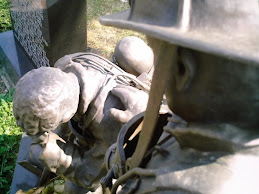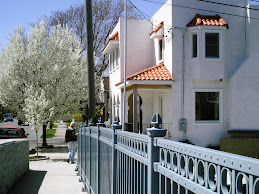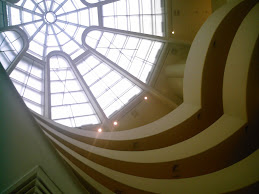By Joseph Kellard
 She is the center of attention in a room at one of the world’s largest museums.
She is the center of attention in a room at one of the world’s largest museums. Diana, a reduction of a weathervane that Augustus Saint-Gaudens created for the top of an early Madison Square Garden, is poised atop a pedestal in the middle of the ground floor at the American Wing in the Metropolitan Museum of Art. What stands out about this sculpture, other than her brilliant gilt, are her subtly contrasting yet complimentary halves that lend her a certain harmony.
First, Diana, the Roman goddess of the moon and the hunt, holds the archer’s standard upright posture — of pointing an arrow and stretching a bow, all the while keeping a steady hand and focus — that denotes tension and intensity. But, unlike archers who also plant their legs evenly apart on the flat earth, Diana assumes a different position that distinguishes her. In contrast to her upper half, she stands decidedly off balance, not only on one foot, but also on her tiptoes while balanced on an orb. This position, combined with her right foot that kicks out slightly behind her, dangling off the pedestal, makes Diana appear, at once and overall, both imbalanced yet stable.
Remember, Diana was created as a weathervane, placed high above on a building, so Saint-Gaudens probably created her right leg to stick outward to provide the wind some mass to help turn her, as is the purpose of her bow and her left arm that holds it. But artistically her leg jutting out adds to her lightness of being and harmony, an airy quality also evoked by her streamlined body and nudity.
The Met recreates this sense of Diana’s purpose by placing her on a high pedestal, above all the grounded sculptures and art-lovers that gaze up at her, just as her original stood atop a tower at Madison Square Garden. In the American Wing, with its windows-framed roof that allows natural light to flood in, Diana’s height and gold cast effectively give this moon goddess a sun-like presence there.


Description of Diana at the base of her pedestal:
Diana
1892-93; this cast, 1928
By Augustus Saint-Gaudens
Aware of Saint-Gauden’s desire to model a female nude, the architect Stanford White (1853 - 1906) gave him the commission for a weathervane for the tower of Madison Square Garden (demolished 1925). The first, eighteen-foot-tall sculpture proved too large and was replaced in 1894 by a streamlined version, five feet shorter. It became one of New York’s most popular landmarks, and the sculptor capitalized on its success by issuing numerous reductions. This cast is a half-sized model of the second version, produced from a cement cast once owned by White. Saint-Gaudens eschewed the traditional full-bodied interpretation of Diana, the Roman goddess of the moon and the hunt, focusing instead on simple, elegant lines and a strong silhouette.


































+-+June+2009.jpg)











No comments:
Post a Comment